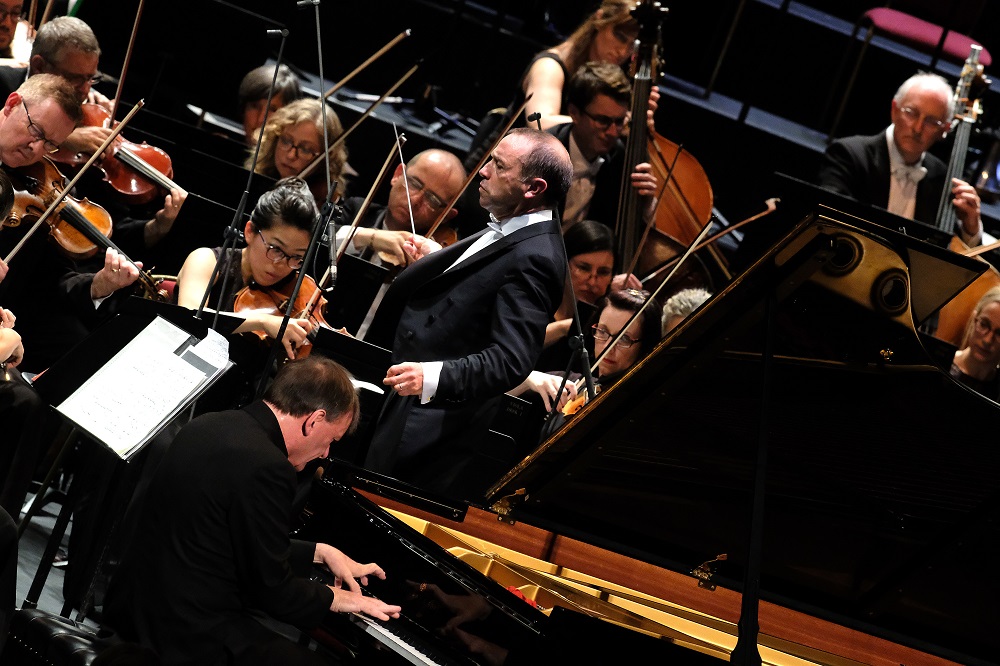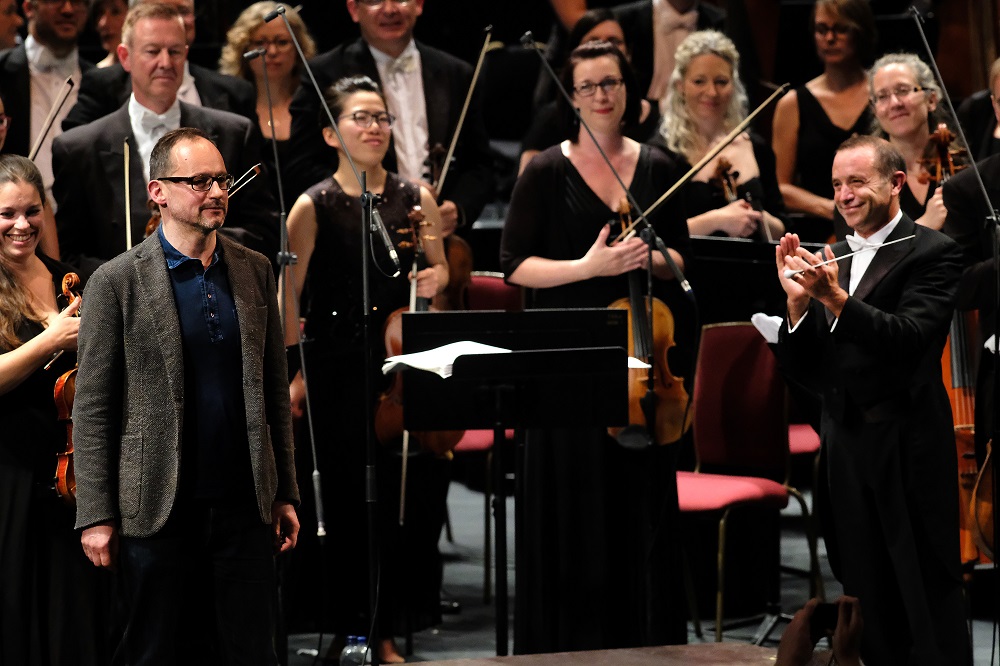Prom 20 review: Hough, BBCPO, Wigglesworth - towards the light fantastic | reviews, news & interviews
Prom 20 review: Hough, BBCPO, Wigglesworth - towards the light fantastic
Prom 20 review: Hough, BBCPO, Wigglesworth - towards the light fantastic
Dancing radiance transforms Haydn, Sawer and even Brahms's First Piano Concerto
Romantic concerto, contemporary work, classical symphony: it's a common format at the Proms, but not usually in that order. Both David Sawer's 1997 firework The Greatest Happiness Principle and Haydn's ever-radical Symphony No.
The idea here was to move from dark and steaky Brahms upwards into Haydn's heaven, but as it turned out there was plenty of dancing radiance in this unusual, often exquisite interpretation of his First Piano Concerto, too. It would really have to be so given that Stephen Hough, so ideal in Chopin and Schumann, is not a natural for the big later-romantic concertos (Brahms, Rachmaninov, Tchaikovsky). He got round the heavier double-octave stuff with plenty of sustaining pedal, but his chief gift, backed up by a constant clarity of line, emphasised how much introspection there is in this work.
David Sawer (pictured below on the left) must have been pleased with the post-interval slot, where - speaking for myself, at least - it seemed so much easier to be alert to every surprising detail in his filigree orchestration once the opening had grabbed us by the throat. The philosophical concept of the piece, a fusion of Bentham's maxim "the greatest happiness for the greatest number" with his semi-circular 1791 design for a Millbank "penitentiary panopticon", must have been a good starting-point for the composer but wouldn't have "read" to the audience. The magic was really in the showpiece textures, muted trumpets especially effective, and the cut-down of lines after the buzzing start, which made us hear phrases and melodies that weren't actually there between the frenetic activity. It was all close in sound to John Adams's "foxtrot for orchestra" The Chairman Dances, but rather more filleted, intriguingly so. And the very funny-bizarre sudden splutter-out of the final bars drew genuine laughter from the audience.
The BBC Philharmonic was a completely different animal from the patchy-sounding ensemble in Juanjo Menja's concert performance of Beethoven's Fidelio a week earlier. Again, you had to lean in to catch the finer nuances in the hall, but they were all there, from the striking timbre of the first E flat major chord - natural trumpets instantly brightening the sound - and the harmonic quirks of a marvellous introduction onwards. The minute you heard the little tune that pops up at the end of the exposition, you knew it was important enough to deserve more of the limelight - which it gets, surprisingly, in development, recap and coda (the first of several vital repeats was welcome, too).
Wigglesworth's extra inflections - bringing the bassoon chuntering to the fore before getting the player to turn down the volume, delicious hesitations for the Minuet's fluent trio with its high oboe line - were all a natural long distance from Rattle's mannerisms. The translucency he got from the players highlighted Haydn's gift for orchestration at every point (how marvellous that drums and trumpets come unexpectedly into the private, woodwind-enchanted world of the not-too-slow movement). And the delicious finale wore its erudition, if not its big joke - wrong-footing even those of us who knew the trick by making us succumb to premature applause - very lightly.
When I wrote about wanting to encore the scherzo of Haitink's out-of-this-world Schumann Second Symphony with the Chamber Orchestra of Europe several weeks back, I didn't think I'd be feeling the same again so soon when it came to Haydn's outer movements. Music-making doesn't get any classier than in either Prom - and if that puts Wigglesworth on a level with Haitink, then so be it. Let's hope a world-class orchestra realises as much and puts our greatest British conductor in charge some time soon.
rating
Share this article
The future of Arts Journalism
You can stop theartsdesk.com closing!
We urgently need financing to survive. Our fundraising drive has thus far raised £49,000 but we need to reach £100,000 or we will be forced to close. Please contribute here: https://gofund.me/c3f6033d
And if you can forward this information to anyone who might assist, we’d be grateful.

Subscribe to theartsdesk.com
Thank you for continuing to read our work on theartsdesk.com. For unlimited access to every article in its entirety, including our archive of more than 15,000 pieces, we're asking for £5 per month or £40 per year. We feel it's a very good deal, and hope you do too.
To take a subscription now simply click here.
And if you're looking for that extra gift for a friend or family member, why not treat them to a theartsdesk.com gift subscription?
more Classical music
 From Historical to Hip-Hop, Classically Black Music Festival, Kings Place review - a cluster of impressive stars for the future
From quasi-Mozartian elegance to the gritty humour of a kitchen inspection
From Historical to Hip-Hop, Classically Black Music Festival, Kings Place review - a cluster of impressive stars for the future
From quasi-Mozartian elegance to the gritty humour of a kitchen inspection
 Shibe, LSO, Adès, Barbican review - gaudy and glorious new music alongside serene Sibelius
Adès’s passion makes persuasive case for the music he loves, both new and old
Shibe, LSO, Adès, Barbican review - gaudy and glorious new music alongside serene Sibelius
Adès’s passion makes persuasive case for the music he loves, both new and old
 Anja Mittermüller, Richard Fu, Wigmore Hall review - a glorious hall debut
The Austrian mezzo shines - at the age of 22
Anja Mittermüller, Richard Fu, Wigmore Hall review - a glorious hall debut
The Austrian mezzo shines - at the age of 22
 First Person: clarinettist Oliver Pashley on the new horizons of The Hermes Experiment's latest album
Compositions by members of this unusual quartet feature for the first time
First Person: clarinettist Oliver Pashley on the new horizons of The Hermes Experiment's latest album
Compositions by members of this unusual quartet feature for the first time
 Gesualdo Passione, Les Arts Florissants, Amala Dior Company, Barbican review - inspired collaboration excavates the music's humanity
At times it was like watching an anarchic religious procession
Gesualdo Passione, Les Arts Florissants, Amala Dior Company, Barbican review - inspired collaboration excavates the music's humanity
At times it was like watching an anarchic religious procession
 Classical CDs: Camels, concrete and cabaret
An influential American composer's 90th birthday box, plus British piano concertos and a father-and-son duo
Classical CDs: Camels, concrete and cabaret
An influential American composer's 90th birthday box, plus British piano concertos and a father-and-son duo
 Cockerham, Manchester Camerata, Sheen, Martin Harris Centre, Manchester review - re-enacting the dawn of modernism
Two UK premieres added to three miniatures from a seminal event of January 1914
Cockerham, Manchester Camerata, Sheen, Martin Harris Centre, Manchester review - re-enacting the dawn of modernism
Two UK premieres added to three miniatures from a seminal event of January 1914
 Kempf, Brno Philharmonic, Davies, Bridgewater Hall, Manchester review - European tradition meets American jazz
Bouncing Czechs enjoy their Gershwin and Brubeck alongside Janáček and Dvořák
Kempf, Brno Philharmonic, Davies, Bridgewater Hall, Manchester review - European tradition meets American jazz
Bouncing Czechs enjoy their Gershwin and Brubeck alongside Janáček and Dvořák
 Solomon, OAE, Butt, QEH review - daft Biblical whitewashing with great choruses
Even a top soprano and mezzo can’t make this Handel paean wholly convincing
Solomon, OAE, Butt, QEH review - daft Biblical whitewashing with great choruses
Even a top soprano and mezzo can’t make this Handel paean wholly convincing
 Two-Piano Gala, Kings Place review - shining constellations
London Piano Festival curators and illustrious friends entertain and enlighten
Two-Piano Gala, Kings Place review - shining constellations
London Piano Festival curators and illustrious friends entertain and enlighten
 Echo Vocal Ensemble, Latto, Union Chapel review - eclectic choral programme garlanded with dance
Beautiful singing at the heart of an imaginative and stylistically varied concert
Echo Vocal Ensemble, Latto, Union Chapel review - eclectic choral programme garlanded with dance
Beautiful singing at the heart of an imaginative and stylistically varied concert
 Scott, Irish Baroque Orchestra, Whelan, RIAM, Dublin review - towards a Mozart masterpiece
Characteristic joy and enlightenment from this team, but a valveless horn brings problems
Scott, Irish Baroque Orchestra, Whelan, RIAM, Dublin review - towards a Mozart masterpiece
Characteristic joy and enlightenment from this team, but a valveless horn brings problems

Add comment